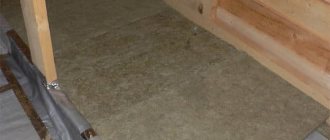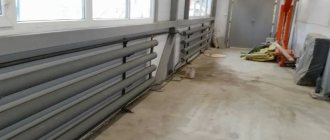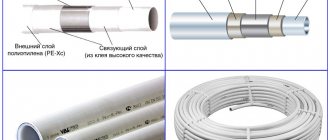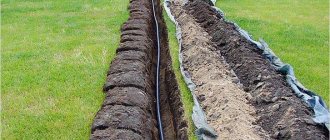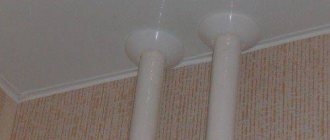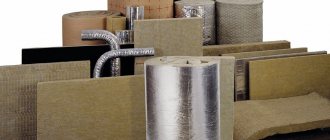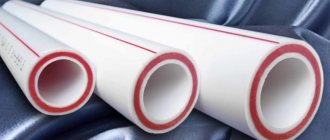For central and autonomous heating systems, a common problem is a decrease in the temperature of the coolant as it moves through the pipeline. First of all, this applies to external sections of the heating network, but also inside the building in some areas, thermal insulation of heating and hot water supply pipes is required to avoid heat loss.
Variety of materials
Communications inside the house, as well as within your own land, can be insulated yourself by choosing the right materials. By insulating the heating main and hot water pipeline, you will achieve:
- reducing heat losses in areas where the heat supply pipeline is laid above ground or passes through unheated (including basement) premises;
- reducing the risk of corrosion on the outside of metal pipes;
- preventing freezing of the coolant when the boiler is stopped (freezing of the system leads to its failure due to burst pipes);
- saving money on heating the house and preparing water for hot water supply.
Types of materials for thermal insulation
Insulation of heating network pipelines increases the efficiency of the system, reduces the load on the heating boiler, and helps save fuel. For these purposes, thermal insulation is used for pipes of various types; when choosing, you should take into account the functional features of insulating materials and the principles of their installation.
The following types of thermal insulation are distinguished:
:
- roll;
- piece;
- casing;
- sprayable;
- combined.
Types of thermal materials
Thermal insulation materials make it possible to insulate building structures, chimneys, ventilation ducts, and pipelines for various purposes. When choosing a material for insulating pipes with coolant or hot water, which are laid outside the building by ground or air, you should use insulation that is resistant to moisture. The universal properties of heat insulators, with which you can insulate heating pipes on the street and in the house, include
:
- low thermal conductivity;
- resistance to chemically active substances;
- does not corrode;
- fire resistance;
- safety for human health;
- simple installation;
- durability.
When choosing an insulating material for pipelines, the diameter of the pipe, location and operating conditions, and the operating temperature of the transported medium are also taken into account.
Foamed polyethylene
Thermal insulation for heating pipes made of foamed polyethylene is in high demand due to its affordable cost and functionality. The thermal conductivity coefficient of the material is about 0.035 W/m•K, while the material, due to its cellular structure, is lightweight and does not exert a significant load on the pipes.
Foamed polyethylene
Such insulation of heating and hot water pipelines is classified as low-flammable - without exposure to an open flame, the material self-extinguishes. When burning, virtually no toxic substances are released, so polyethylene foam is considered a safe insulation material. The material is not damaged by moisture, it is water- and vapor-tight, so this heat insulator is suitable for insulating external ground and basement communications, including those made of steel pipes.
Manufacturers offer foamed polyethylene in the form of rolled material and finished shells with an internal channel corresponding to standard pipe diameters. This fairly elastic casing has a longitudinal cut, making it easy to put on the pipe. The cut and joints are sealed with mounting tape; in difficult places, the heat pipe is insulated with rolled material, wound in several layers and secured with tape.
In addition to standard polyethylene foam, an innovative version of it is presented on the market - penofol. Its special feature is the aluminum foil outer surface. The reflective metal layer provides increased protection against heat loss. Due to their flexibility, penofol sleeves fit securely to the pipeline even in areas with sharp turns.
Thermal insulation with penofol
Foamed polyethylene and penofol are a good choice for those who want to do their own work on insulating external communications or pipes in unheated rooms. But this material is more suitable for autonomous heating systems, since it is designed for heating up to 75–80 ° C - a higher thermal effect can lead to deformation of the insulation and damage to its structure.
Expanded polystyrene
Expanded polystyrene, commonly known as polystyrene foam, is also used for pipe insulation. The material is characterized by low thermal conductivity (0.036–0.043 W/m•K depending on density) and low weight. Low water absorption and biological inertness make it suitable for use in damp environments. Due to its chemical inertness, polystyrene foam can be used with pipes made of any material. Other advantages include ease of processing (a sharp knife is enough for cutting), simple installation, and affordable price.
Due to the rigidity of foam plastic, insulation of heating main pipelines is produced in the form of molded elements - a shell of two halves of a suitable shape and diameter is put on a straight pipe, a bend or a joint of pipes.
Expanded polystyrene
Disadvantages include the flammability of polystyrene foam with the release of toxic substances. To prevent thermal insulation from spreading fire, it is installed leaving special fire breaks.
Also, foam plastic has low mechanical strength and is destroyed by ultraviolet radiation, so if it is used as insulation for heating pipes outdoors, it is necessary to cover the heat insulator with a casing made of galvanized steel sheet or aluminum. The casing is tightened using clamps or self-tapping screws, protecting the heat-insulated pipes from external influences.
The upper limit of the thermal strength of polystyrene foam is +75 ° C; when heated to higher temperatures, the thermal insulation material may become deformed. Therefore, polystyrene foam is suitable for autonomous heating systems with controlled heating of the coolant.
Mineral wool
The modern market offers innovative types of insulation, but the demand for mineral wool remains stable. This is a classic option for thermal insulation of heating mains, since the material is characterized by practicality and affordable cost.
Mineral wool
Mineral wool varies in the composition of its raw materials - the fibers are made from molten rocks, slag or glass. Slag wool retains heat worse; in addition, the material has an acidic environment and its contact with steel pipes is undesirable due to the risk of corrosion. Glass wool tends to cake and lose its shape; when installing it, you cannot do without protective equipment that protects the skin, eyes and respiratory organs from the smallest particles of glass. Thermal insulation made from stone (basalt) fiber is the most durable and effective.
Mineral wool made from glass and basalt fibers is characterized by:
- low thermal conductivity;
- fire safety (the material is resistant to fire, it is used for laying in fire breaks when thermally insulating pipelines with polymeric materials);
- resistance to aggressive environments, biological damage;
- elasticity - rolled mineral wool is easy to install.
Video description
The following video shows how mineral wool cylinders are mounted on a pipeline:
Insulation made of polystyrene foam and polystyrene foam
Insulating pipes with foam plastic is the simplest and most inexpensive way to insulate them. This material has all the necessary properties: it does not burn, withstands stress well, does not emit toxic substances, almost does not absorb water, is very easy to install and can be used repeatedly. Its only drawback is its attractiveness to mice and other rodents. Which, however, is unimportant when insulating underground pipelines, for which it is most often used.
Extruded polystyrene foam has even better technical characteristics - it is denser and more moisture-resistant, and better resists the destructive effects of ultraviolet rays.
Both materials are produced in the form of so-called shells - sections that are halves of a cylinder with a tongue-and-groove connection. They can be covered with a protective foil shell. This design allows the insulation to be used repeatedly, removing it for inspection or repair of communications.
“Shell” for insulating foam pipes Source standartt.ru
The high density and compressive strength that such thermal insulation of pipelines has allows it to be used both for external pipes and for underground pipelines without installing rigid trays. For various nodes and turns, corresponding shaped shells are produced.
To lay several pipes or large-diameter pipes, special multi-profile segments or slabs of polystyrene foam or expanded polystyrene can be used, from which strips are cut and the box is assembled. Its walls are fastened with polyurethane foam.
Warm polystyrene box Source i.ytimg.com
For reference! Foam glass has similar properties and characteristics, characterized by absolute waterproofness, non-flammability, inertness to chemicals, but also a high price. The form of production of pipe insulation from this material is shells, segments, shaped parts.
Polyurethane foam insulation
Polyurethane foam is one of the most modern insulation materials, which is a cellular polymer material whose closed cavities are filled with carbon dioxide. It makes very effective thermal insulation for heating and water supply pipes.
On sale you can find pipes already insulated with polyurethane foam and covered with a protective sheath: polyethylene for underground installation and galvanized steel for surface installation.
Source https://ks-teplo.ru/assets/images/%D0%9F%D0%9F%D0%A3.jpg
Calculation of the thickness of the thermal insulation layer
The choice of insulation should take into account the thickness of the thermal insulation layer. This value is calculated based on current standards.
Heat losses in an insulated pipeline should not exceed the values regulated by SNiP. To simplify the calculations, the resistance of the walls of metal pipes to heat conduction is not taken into account (it is extremely low), as well as heat loss when heating the walls of pipes protected by thermal insulation.
Additional files with tables for calculation can be obtained from the link [293.59 Kb] (downloads: 25).
Protection of external communications
Insulation of heating pipes on the street is necessary if the boiler unit and radiators are installed in different buildings. Laying an external pipeline will cost less than installing an underground network, and covering communications with heat-insulating materials will help avoid heat loss and extend the life of the pipes. This way they will not require immediate repair or replacement.
When choosing how to insulate pipes outside the house, preference should be given to moisture-resistant materials and the installation of a hard casing to protect against mechanical and other external influences.
Thermal insulation of pipelines in a building
If the heating boiler is installed at a large distance from the radiator closest to it, and the pipeline passes through an unheated room, it is recommended to choose a method of thermal insulation so that the temperature of the coolant does not decrease.
It is important to insulate heating pipes in the basement, as well as in places where the pipeline passes through the walls, so that energy is not wasted on heating building structures. For interior work, use a safe heat insulator that is resistant to combustion and does not emit harmful substances.
Various materials are used to insulate heating pipes and other communications. One of the common ones is covers made of foamed polyethylene (usually gray). But they can only be used for communications with a small diameter, for example, for polypropylene pipes. If we are talking about central networks, then thermal insulation of pipelines with mineral wool has no alternatives.
Factors causing heat loss
When placing the entire heating system in one room, heat loss would be minimal - only through contact of the unit and pipeline with the foundations, the rest of the heat from all elements of the system would be transferred to the air environment of the home. But in practice, there are always a number of factors that cause thermal energy losses:
- the boiler and part of the pipeline are often located in rooms where heating is not necessary;
- the boiler is mounted in a separate building and connected to the heating system by an external pipeline;
- The heating system of a private home consumes coolant from a central main, located at some distance from the house.
To increase the efficiency of the heating boiler and reduce heat loss in all these cases, insulation is intended for heating pipes located outside the area requiring heating.
Not only heating pipelines are equipped with thermal insulation; for the following reasons, water supply and sewerage pipes are also insulated:
- the hot water supply system needs thermal insulation to maintain the water temperature as it moves from the heat exchanger to the water intake point;
- In winter, ordinary water supply and sewage systems without thermal insulation equipment will freeze and fail.
In addition to reducing heat loss and preventing freezing of pipelines, thermal insulation for heating pipes performs another function - protection against burns in direct contact with the human body. To successfully perform their tasks, thermal insulation materials must have certain characteristics based on the requirements placed on them.
For which pipelines is mineral wool used?
Mineral wool can be used in combination with other insulation materials.
Thermal insulation of pipelines with mineral wool is a set of measures aimed at reducing heat transfer in the following communication systems:
- heating;
- hot water supply;
- water pipes;
- sewerage;
- conditioning.
How pipeline insulation work is carried out
Thermal insulation must be carried out in accordance with current standards and regulations, which guarantees effective energy saving and increased useful life
.
The installation of thermal insulation of pipelines, based on the article, can actually be done using various materials, but taking into account certain factors and, above all, the direct purpose of the future installed system.
For example, the thermal insulation of pipelines with a high temperature of the medium transported through it is best done using cylinder insulation (PUF shell), additionally laminated with foil cardboard or foil.
What materials are used for pipe insulation?
Shells with foil for pipe insulation.
Mineral wool is the general name for all fibrous thermal insulation materials, for the production of which various types of minerals are used. In civil engineering, only two types of mineral wool are used for pipes:
- glass wool;
- basalt wool.
Glass wool is made from quartz or its derivative (glass). The fibers of this material are long and soft, they do not break, so a material of any configuration is suitable for insulating pipes with fiberglass mineral wool. Glass wool is produced in slabs, mats, rolls and cylinders. If you do not take into account the cylinders (shells), then the differences lie only in the length of the material. The slabs are the shortest, the mats are twice as long, and the rolls are the longest. The size depends on the manufacturer, there is no general standard. Thickness from 50 to 150 mm. Each of the products can be laminated with foil.
There is a pattern: as the density of a thermal insulation material increases, its thermal conductivity also increases, that is, it works worse as insulation.
Mineral wool for insulating pipes in cylinders consists of two parts - this is a sleeve, the internal cross-section of which is equal to the outer diameter of the communications. The nominal diameter of the shells varies from 18 to 1024 mm. Insulation thickness is from 20 to 80 mm, standard length is 1 m. They can also be covered on the outside with foil. General characteristics for all fiberglass insulation:
- thermal conductivity lambda 0.036-0.042 W/m*k;
- high hygroscopicity;
- flammability class NG.
Fiberglass mineral wool for pipelines is much lighter than basalt insulation, and accordingly, its density is also lower. Basalt wool for pipes is produced only in shells and lamella rolls - these are many narrow rectangles (lamellas) glued to a base. Basalt is a volcanic rock, essentially a stone, hence the name of the material. Stone wool is very dense, its fibers are short and inelastic. They break and this creates dust. A priori, it will not be possible to wrap communications with a regular basalt slab; it will simply break.
Keep in mind that a home air heater can burn oxygen. Pay attention to the configuration of the heating element.
Here we describe the principle of operation of a fireplace with a water circuit, which is capable of heating a medium-sized house.
Polyurethane foam (PPU)
This material is no less effective insulation. To insulate the pipes, a polyurethane foam shell is used , which is a cylinder. It is made in two ways:
- By pouring liquid polyurethane under high pressure into a special mold:
- Manufactured using the “pipe in pipe” method . In this case, the material is poured into the cavity between two pipes - the inner one, with a smaller diameter, and the outer one, with a larger diameter.
The first option is suitable for yourself . And the product of the second production method is pre-insulated pipes ready for laying a new pipeline .
- This is a completely new product that makes it possible not to think about additional insulation ;
- In this case, the outer layer can be corrugated - flexible, which makes it possible to avoid the need to use rotary fittings , that is, the pipeline can be laid with a minimum number of connections;
- Both one- and two-pipe versions of such ready-made elements are produced;
- For laying cold pipeline designs are better suited with plastic pipes;
- For hot dishes, they produce more expensive options with metal pipes inside;
- Flexible pipes with pre-insulation are supplied in coils and have a length of up to 200 meters .
Regarding PU shell , it has the following advantages:
- Heat loss is reduced by almost 40% ;
- Installation of the elements is so simple that it allows you to independently insulate several hundred meters of pipeline in a day;
- This also indicates the speed of installation;
- The material is environmentally friendly ;
- The insulation can be reused an unlimited number of times;
- Term operation reaches 30 years.
Among the disadvantages is the impossibility of using the material at temperatures above 120°C . A great convenience is the presence of shaped segments, such as tees, elbows and branches. The connection of two shell fragments to each other occurs using a special coupling , which makes the thermal insulation airtight and prevents the possibility of the formation of cold bridges.
The shell also
differs in the material of its outer covering, which determines its scope of application. The coating can protect both from environmental factors, such as ultraviolet radiation, and from mechanical influences.
- Uncoated polyurethane foam is the most affordable, but can only be used for insulating pipes located, for example, in the basement, and then only if there is an additional casing . Either as an intermediate insulating layer;
- Shell with foil coating - the scope of application is not limited, and the material is characterized by increased strength ;
- Shells coated with fiberglass can be used to insulate external sections of the pipeline, for example, places where pipes enter the house. It is distinguished by its resistance to ultraviolet radiation . At the same time, fiberglass is also distinguished by high hardness , which virtually eliminates the possibility of mechanical damage ;
- The glassine coating is resistant to direct sunlight, but is inferior to fiberglass in strength;
- Shell coated with reinforced aluminum foil (armofol) - used for insulation of pipelines operated under conditions of significant temperature changes ;
- Galvanized steel coating is used to insulate pipelines running in air . Steel protects the shell from ultraviolet radiation, mechanical and biological influences, but at the same time is more affordable than a fiberglass coating.
The thickness of the shell is 20-80 mm and increases with increasing diameter. The length of one element does not exceed 1 meter , taking into account the peculiarities of the manufacturing process.
Pipeline insulation method
This state of affairs leads to colossal heat losses.
Thermal insulation of pipes with mineral wool is carried out taking into account the high hygroscopicity of the material, that is, the ability of the insulation to absorb and retain moisture. At the same time, when the insulator gets wet, it loses its qualities, and instead of insulation, on the contrary, it accelerates heat loss. Therefore, you need to use waterproofing. Roofing felt or foil is often used for this purpose.
The foil on the thermal insulation itself also saves the material from moisture, but the ends remain unprotected, through which water can easily penetrate inside. The installation method for roll insulation is extremely simple:
- communications are wrapped in mineral wool for pipelines so that each subsequent turn overlaps the previous one by 5 cm;
- the insulation is fixed with wire;
- Using the same principle, the waterproofing is screwed on and clamped with stainless wire.
If the insulation of pipelines with mineral wool is carried out with foil materials, then the reflective surface is placed outside. Installing the cylinders is even easier. You just need to put the shell on the pipe like a cover. A special glue is applied to the longitudinal section of the heat-insulating cylinder, which is protected with paper tape. The tape is removed during installation.
When laying communications underground, any thermal insulation must be protected from mechanical influences, because the weight of the earth is considerable. Therefore, the pipes along with thermal insulation are placed in plastic sleeves. Large diameter PVC sewer pipes are suitable. There are also special insulated pipes on sale, covered with a polymer layer.
Video description
For another method of installing insulation, see the following video:
If the insulation is made in the form of cylinders, installation is greatly simplified: the elements are simply put on the pipe, and the edges of the cut are glued together, as are the vertical joints between the cylinders. If there is no adhesive layer applied to the edges, then foil tape is used for connection.
Advice! If thermal insulation of an underground pipeline is required, then it is advisable to additionally protect it from moisture by placing it in a large-section plastic pipe.
In the case of insulation made of foam plastic or a similar material in the form of a rigid shell, it is recommended that installation be carried out with the halves of the shells offset along the length by 10-20 cm. This overlap will ensure a more reliable fastening of all elements. During the installation process, all joints are carefully taped.
An offset along the length provides a more reliable fastening Source teplolivada.ru
All kinds of turns, corners, tees and other joints are insulated using shaped parts or homemade boxes made of sheet material. Or they are treated with thin-layer liquid thermal insulation.
Results
Mineral wool for pipeline insulation comes in two types: glass wool and stone (basalt) wool. Any glass wool can be used (plates, mats, rolls, with or without foil). It is soft and elastic, you can wrap it around communications without any problems. Stone wool is inelastic, so only lamella mats can be used. There are also thermal insulation cylinders made of mineral wool - these are sleeves, the nominal diameter of which must be equal to the outer diameter of the pipe. Cylinders come in different diameters, thicknesses, with or without foil.
Thermal insulation of pipelines of various types is one of the priority areas of modern energy saving. Through the use of high-quality materials with unique characteristics and the best technologies, it is possible to significantly reduce heat loss, as well as protect the pipes themselves and, accordingly, the transported substances from the negative effects of significant temperature changes.
The structure of the substance that is part of the insulation
High pressure thermal insulation
As a method of insulating a pipeline in a private house or country house, one can consider creating and maintaining high pressure in it. How it's done:
- to embed a receiver into the finished pipeline , which will have to create the necessary pressure - 3-5 atmospheres is quite enough;
- It is also necessary to additionally use submersible pump, to create pressure from 5 to 7 atm.;
- After the pump, a check valve and a tap are installed in front of the receiver;
- To start the system, you need to close the tap in front of the receiver and turn on the pump;
- The resulting pressure must be maintained in the system continuously until it is in use;
- To allow the pipeline to function again, you simply need to bleed off the excess air.
Thermal insulation of pipes: an important necessity
High-quality and inexpensive insulation of pipeline systems is essential everywhere, from small country houses to large industrial enterprises, shopping complexes, etc.
If you include thermal insulation in the project initially and carry it out in the first stages of construction, you can save significant money on the repair and operation of trunk networks.
If we talk about the requirements for insulating materials for pipes, they depend on specific types of pipelines, as well as their operating conditions. In general, the main task of thermal insulation is to protect the insulated surfaces for the longest possible time.
Often, thermal insulation materials made from mineral fibers meet all these requirements - their characteristics are simply ideal for various types of pipelines.
Insulation of pipelines indoors
It should be noted that in the case of using mineral wool insulation for water supply networks, air conditioning and refrigeration equipment, it is possible to effectively protect structures from freezing, corrosion, and condensation.
In addition, high-quality materials will help reduce heat loss in the lines and significantly extend the life of trouble-free operation.
Main characteristics and features
Modern mineral wool thermal insulation is a fibrous material that is obtained by melting mountain silicates, slags, and their mixtures. Depending on the type of raw material used, insulating mineral wool can be either stone or slag.
Insulation requirements
Thermal insulation of pipes provides for a number of technical regulatory documents, compliance with which is mandatory when designing, installing and operating engineering systems of residential and public buildings, and other objects for various purposes.
More detailed information is provided on the website:
https://www.ktto.com.ua/norm/teplo_pot
It should be noted that industrial thermal insulation refers to the thermal insulation of pipelines, containers, as well as equipment and tanks.
Thermal insulation is carried out to prevent cooling of the liquid present in the pipes or to avoid the formation of condensation on the equipment. If heat loss is not so important, then this technological process is necessary to comply with safety regulations.
Various versions of insulators are being considered for insulating pipes used for gas transportation.
Thermal insulation of the gas pipeline is carried out using a special varnish or paint, but usually they resort to modern protective materials that meet all the requirements for this, namely:
- the insulator for the gas pipeline must be endowed with the potential of a monolithic, uniform installation on the pipe;
- the material for thermal insulation of the pipeline must be characterized by a low coefficient of water absorption and have high waterproofing qualities;
- protect the structure from destructive ultra-radiation.
Advantages of using mineral wool cylinders
A thermal insulation cord made of mineral wool or a full-fledged cylinder made of a unique material is the best option for insulating pipelines of various types.
Using this particular form of heat insulator has a lot of advantages and disadvantages, among which are:
- Low level of thermal conductivity. Inside the layer of the mineral wool cylinder there is a large volume of air, which (thanks to the thin and flexible fibers of the material) remains motionless and does not allow heat to pass through;
- Resistant to fire and high temperatures. The instructions for mineral wool cylinders indicate that they are non-flammable, do not melt and do not lose their shape even when exposed to extremely high temperatures (from -150C to +750C);
- Long term trouble-free operation. The use of basalt rocks and slag as raw materials extends the service life of mineral wool-based insulation by almost decades. On average, even the most inexpensive heat insulator can last 50-60 years without losing its performance qualities;
Variety of shapes and sizes of insulation materials
- Durability and reliability. Mineral wool easily withstands even the highest loads and pressure. Cotton wool has closely interwoven fibers, and therefore its density and strength are significantly increased;
- Hydrophobicity. The insulation has increased resistance to moisture thanks to protective layers of foil and fiberglass, due to this it is not afraid of direct contact with water. If necessary, the materials can be additionally treated with special water-repellent compounds;
Advice. If the pipeline is to be used in conditions of high humidity, then it is best to subject the mineral wool to additional processing. Thus, it will be possible to extend the life of the highway and significantly reduce the cost of maintenance and repairs.
- Availability. The price of mineral wool heat insulators is in an affordable range, which allows them to be used for insulation of even long pipelines;
- Ease of use. Anyone can insulate even large volumes of pipelines with their own hands. The thermal insulation process is quite simple, requiring the use of only available materials;
Half-cylinders made of mineral wool
- Environmental friendliness. Cylinders and semi-cylinders made from natural raw materials are absolutely safe for human health and the environment. As a result, mineral wool materials can be used to insulate any pipes.
Efficiency and benefits of using mineral wool insulation for pipes
Thermal insulation materials made of mineral wool, made in the form of cylinders, make it possible to achieve high efficiency and provide the best operating conditions for highways:
- Heat losses in straight sections of pipelines when using mineral wool will be reduced by almost 3.6 times. Unlike other materials, it loses only 8% of heat, which is very important, especially for hot water supply systems;
- Reducing the time spent on thermal insulation. There is no longer any need to wrap pipes with fiberglass and mineral wool mats - the cylinders have an internal diameter similar to the dimensions of the main line;
Simple cutting of material with a knife during installation
- Protective coatings will help prevent damage to the cylinders from the insulation and maintain the level of thermal insulation for a long time. At the same time, the thickness of the insulating layer is not lost throughout the entire service life.
Advice. To simplify the process of covering pipes with mineral wool insulation in the form of cylinders and half-cylinders, the use of a construction knife will help. Cutting materials with such a tool is much easier, and dimensional accuracy can be maintained.
Thermal insulation materials made on the basis of mineral wool in the shape of cylinders are an excellent option for pipes of any type, size and length.
It should be noted that the domestic market is filled with offers from various manufacturers; you can choose the right type of insulation specifically for a specific pipeline with a certain diameter, length and types of transported material.
The use of special coatings for additional protection of thermal insulation materials from the negative effects of mechanical damage and other factors
Foamed polyethylene
Many experts note that among the variety of thermal insulation materials, it is polyethylene varieties that are the most optimal in terms of price/quality ratio. The structure of polyethylene consists of many closed cells, inside of which there is air, which, as is known, has the lowest thermal conductivity coefficient - only 0.024 W/m*K. There are:
- cross-linked (FPPE or HPPE) polyethylene foam, which is obtained by foaming the molten composition;
- non-crosslinked (NPE) polyethylene foam, for the production of which an extruder is used.
The structure of NPE is long linear molecules, between which there is no chemical bond. While cross-linked polyethylene has a denser consisting of smaller cells , with a stable molecular bond. You can even distinguish these two varieties visually.
Depending on the production method, the technical characteristics differ .
- Cross-linked polyethylene will have a lower thermal conductivity and higher density , making it resistant to deformation. But its cost higher than unstitched. Density ranges from 25 to 40 kg/m3 ;
- The material has increased elasticity , which is maintained even at low temperatures (-80°C) . This makes installation much easier;
- With a force of 5000 N/m2. the compression ratio of polyethylene is only 0.2;
- Due to the minimum value of the vapor permeability , which is 0.001 mg/m*h*Pa, the material can be classified as completely vapor-proof ;
- Coefficient of thermal conductivity amounts to 0.035 W/m*K;
- Polyethylene also has a low water absorption rate . When the material is immersed in water for a day, it absorbs no more than 0.5% of moisture from its volume. Moreover, upon reaching the figure of 1.9% after more time, water absorption stops increasing;
- The flammability class of the material is G2 ( moderately flammable );
- Moreover, in the event of inflammation, the material does not release substances to the body ;
- The structure of the material is not susceptible to the effects of various chemical elements .
- Polyethylene may have release form in the form of hollow cylinders with a technical slot along the entire length, sheets and rolls.
The material may have an additional protective layer of foil .
Conclusion
Mineral wool is an insulation with unique characteristics, the best option if it is necessary to protect pipelines of various categories from the negative effects of temperature changes, the negative effects of various factors, ranging from chemicals to mechanical damage.
Due to their convenient form and affordable cost, you can choose the most optimal heat insulators for each specific case, ensuring a wide range of work is completed without wasting time and money.
In the video presented in this article you will find additional information on this topic. The process itself is very simple, accessible to every person, even those not prepared for construction work.

